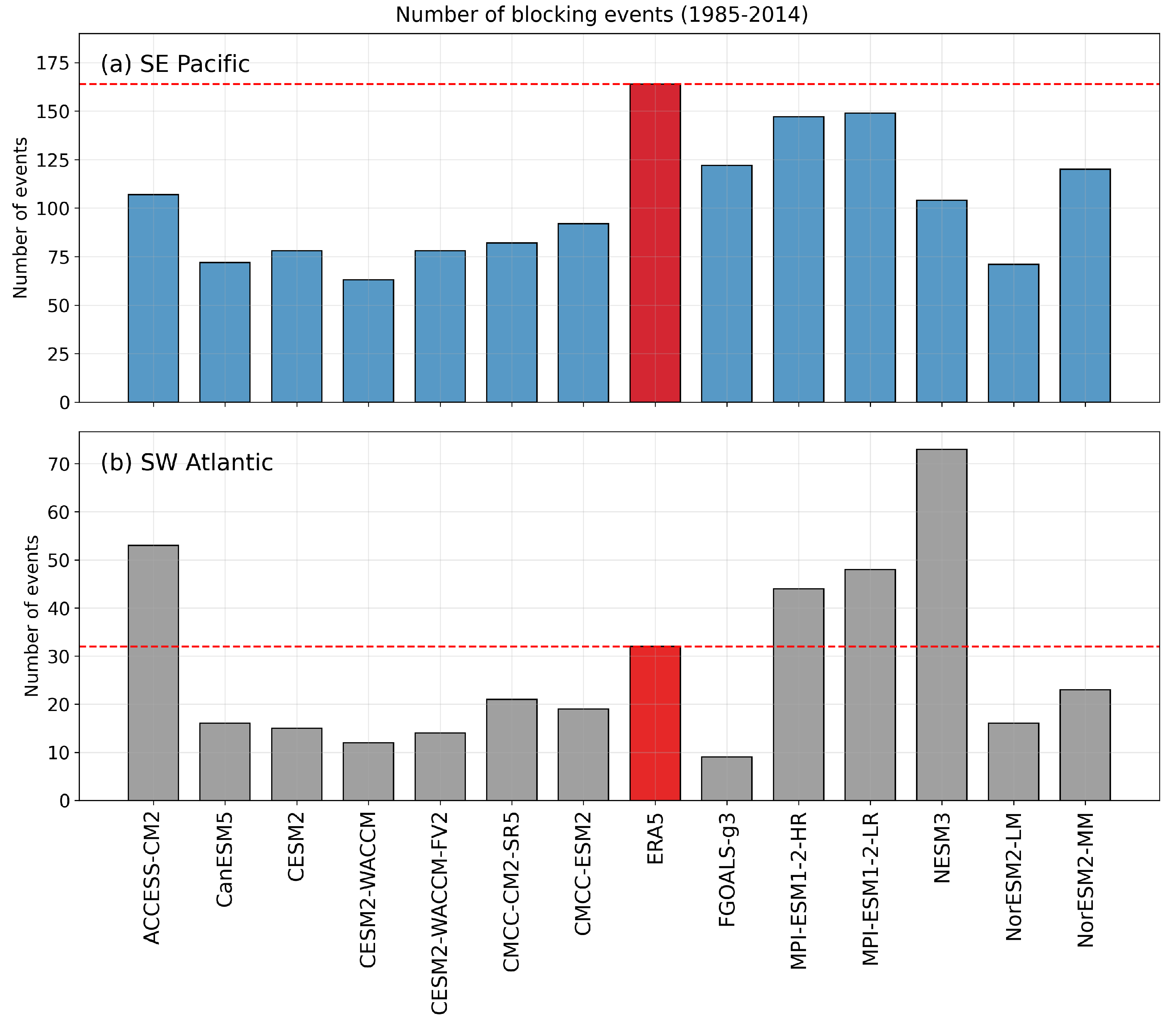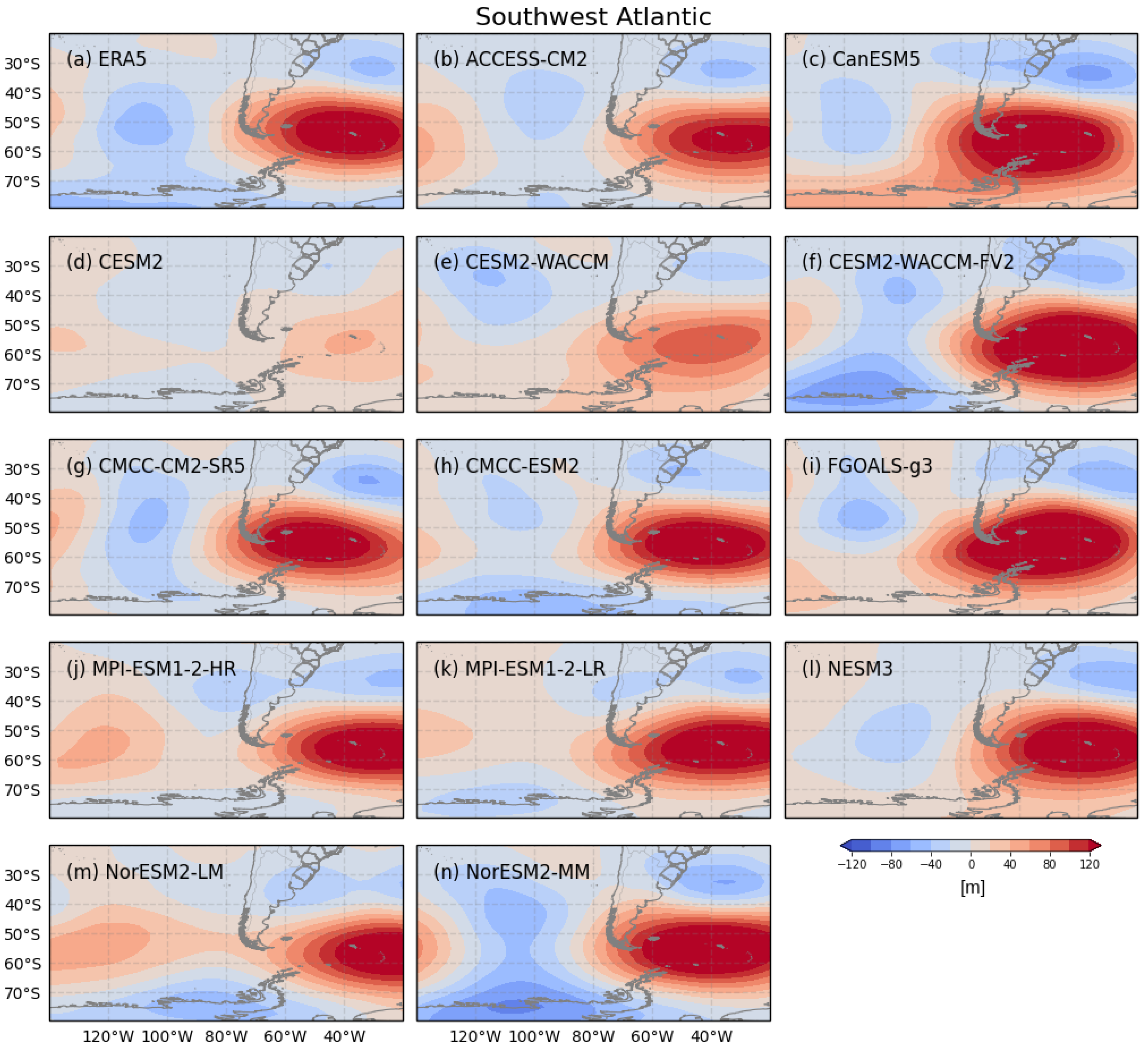Atmospheric Blocking Events over the Southeast Pacific and Southwest Atlantic Oceans in the CMIP6 Present-Day Climate
Abstract
:1. Introduction
2. Materials and Methods
2.1. Data
2.2. Blocking Index
- ;
- ;
- ;
- ;
- .
3. Results
3.1. Frequency of the Blocking Events
3.2. Duration of the Blocking Events
3.3. Spatial Patterns of the Blocking Events
4. Conclusions
Author Contributions
Funding
Data Availability Statement
Acknowledgments
Conflicts of Interest
References
- Rex, D.F. Blocking action in the middle troposphere and its effect upon regional climate. Tellus 1950, 2, 275–301. [Google Scholar]
- Marengo, J.A.; Ambrizzi, T.; Barreto, N.; Cunha, A.P.; Ramos, A.M.; Skansi, M.; Molina Carpio, J.; Salinas, R. The heat wave of October 2020 in central South America. Int. J. Climatol. 2021, 42, 2281–2298. [Google Scholar] [CrossRef]
- Marengo, J.A.; Cunha, A.P.; Cuartas, L.A.; Deusdará Leal, K.R.; Broedel, E.; Seluchi, M.E.; Michelin, C.M.; De Praga Baião, C.F.; Chuchón Angulo, E.; Almeida, E.K.; et al. Extreme drought in the Brazilian Pantanal in 2019–2020: Characterization, causes, and impacts. Front. Water 2021, 3, 639204. [Google Scholar] [CrossRef]
- Coelho, C.A.; de Oliveira, C.P.; Ambrizzi, T.; Reboita, M.S.; Carpenedo, C.B.; Campos, J.L.P.S.; Tomaziello, A.C.N.; Pampuch, L.A.; Custódio, M.d.S.; Dutra, L.M.M.; et al. The 2014 southeast Brazil austral summer drought: Regional scale mechanisms and teleconnections. Clim. Dyn. 2016, 46, 3737–3752. [Google Scholar] [CrossRef]
- Rodrigues, R.R.; Woollings, T. Impact of atmospheric blocking on South America in austral summer. J. Clim. 2017, 30, 1821–1837. [Google Scholar] [CrossRef]
- Mendes, M.C.D.; Trigo, R.M.; Cavalcanti, I.F.; DaCamara, C.C. Blocking episodes in the Southern Hemisphere: Impact on the climate of adjacent continental areas. Pure Appl. Geophys. 2008, 165, 1941–1962. [Google Scholar] [CrossRef]
- Lupo, A.R. Atmospheric blocking events: A review. Ann. N. Y. Acad. Sci. 2021, 1504, 5–24. [Google Scholar] [CrossRef]
- Mendes, M.C.D.; da Silva Aragão, M.R.; Mendes, D.; Mesquita, M.D.; Correia, M.d.F.; Cavalcanti, E.P. Synoptic-dynamic indicators associated with blocking events over the Southeastern Pacific and South Atlantic oceans. Clim. Dyn. 2022, 60, 2285–2301. [Google Scholar] [CrossRef]
- Lejenäs, H. Characteristics of Southern Hemisphere blocking as determined from a time series of observational data. Q. J. R. Meteorol. Soc. 1984, 110, 967–979. [Google Scholar] [CrossRef]
- Tibaldi, S.; Tosi, E.; Navarra, A.; Pedulli, L. Northern and Southern Hemisphere seasonal variability of blocking frequency and predictability. Mon. Weather Rev. 1994, 122, 1971–2003. [Google Scholar] [CrossRef]
- Wiedenmann, J.M.; Lupo, A.R.; Mokhov, I.I.; Tikhonova, E.A. The climatology of blocking anticyclones for the Northern and Southern Hemispheres: Block intensity as a diagnostic. J. Clim. 2002, 15, 3459–3473. [Google Scholar] [CrossRef]
- Davini, P.; D’Andrea, F. Northern Hemisphere atmospheric blocking representation in global climate models: Twenty years of improvements? J. Clim. 2016, 29, 8823–8840. [Google Scholar] [CrossRef]
- Woollings, T.; Barriopedro, D.; Methven, J.; Son, S.W.; Martius, O.; Harvey, B.; Sillmann, J.; Lupo, A.R.; Seneviratne, S. Blocking and its response to climate change. Curr. Clim. Chang. Rep. 2018, 4, 287–300. [Google Scholar] [CrossRef]
- Davini, P.; d’Andrea, F. From CMIP3 to CMIP6: Northern Hemisphere atmospheric blocking simulation in present and future climate. J. Clim. 2020, 33, 10021–10038. [Google Scholar] [CrossRef]
- Liu, P.; Reed, K.A.; Garner, S.T.; Zhao, M.; Zhu, Y. Blocking Simulations in GFDL GCMs for CMIP5 and CMIP6. J. Clim. 2022, 35, 5053–5070. [Google Scholar] [CrossRef]
- Patterson, M.; Bracegirdle, T.; Woollings, T. Southern Hemisphere atmospheric blocking in CMIP5 and future changes in the Australia-New Zealand sector. Geophys. Res. Lett. 2019, 46, 9281–9290. [Google Scholar] [CrossRef]
- Hersbach, H.; Bell, B.; Berrisford, P.; Hirahara, S.; Horányi, A.; Muñoz-Sabater, J.; Nicolas, J.; Peubey, C.; Radu, R.; Schepers, D.; et al. The ERA5 global reanalysis. Q. J. R. Meteorol. Soc. 2020, 146, 1999–2049. [Google Scholar] [CrossRef]
- Oliveira, F.N.; Carvalho, L.M.; Ambrizzi, T. A new climatology for Southern Hemisphere blockings in the winter and the combined effect of ENSO and SAM phases. Int. J. Climatol. 2014, 34, 1676–1692. [Google Scholar] [CrossRef]
- Oliveira, F.N.; Ambrizzi, T. The effects of ENSO-types and SAM on the large-scale southern blockings. Int. J. Climatol. 2016, 37, 3067–3081. [Google Scholar] [CrossRef]
- Yuchechen, A.E.; Lakkis, S.G.; Canziani, P.O. The Southern Hemisphere blocking index revisited. Atmosphere 2022, 13, 1343. [Google Scholar] [CrossRef]
- Kalnay, E.; Kanamitsu, M.; Kistler, R.; Collins, W.; Deaven, D.; Gandin, L.; Iredell, M.; Saha, S.; White, G.; Woollen, J.; et al. The NCEP/NCAR 40-year reanalysis project. Bull. Am. Meteorol. Soc. 1996, 77, 437–471. [Google Scholar] [CrossRef]
- Saha, S.; Moorthi, S.; Pan, H.L.; Wu, X.; Wang, J.; Nadiga, S.; Tripp, P.; Kistler, R.; Woollen, J.; Behringer, D.; et al. NCEP climate forecast system reanalysis (CFSR) monthly products, January 1979 to December 2010. Bull. Am. Meteorol. Soc. 2010, 91, 1015–1057. [Google Scholar] [CrossRef]
- Sinclair, M.R. A climatology of anticyclones and blocking for the Southern Hemisphere. Mon. Weather Rev. 1996, 124, 245–264. [Google Scholar] [CrossRef]







| GCM | Climate Centre | Lat × Lon |
|---|---|---|
| ACCESS–CM2 | Commonwealth Scientific and Industrial Research Organization (Australia) | |
| CanESM5 | Canadian Centre for Climate Modelling and Analysis (Canada) | |
| CESM2 | National Centre for Atmospheric Research (USA) | |
| CESM2–WACCM | National Centre for Atmospheric Research (USA) | |
| CESM2–WACCM–FV2 | National Centre for Atmospheric Research (USA) | |
| CMCC–CM2–SR5 | Euro–Mediterranean Centre on Climate Change (Italy) | |
| CMCC–ESM2 | Euro–Mediterranean Centre on Climate Change (Italy) | |
| FGOALS–g3 | Chinese Academy of Sciences (China) | |
| MPI–ESM1–2–HR | Max Planck Institute for Meteorology (Germany) | |
| MPI–ESM1–2–LR | Max Planck Institute for Meteorology (Germany) | |
| NESM3 | Nanjing University of Information Science and Technology (China) | |
| NorESM2–LM | Norwegian Climate Center (Norway) | |
| NorESM2–MM | Norwegian Climate Center (Norway) |
Disclaimer/Publisher’s Note: The statements, opinions and data contained in all publications are solely those of the individual author(s) and contributor(s) and not of MDPI and/or the editor(s). MDPI and/or the editor(s) disclaim responsibility for any injury to people or property resulting from any ideas, methods, instructions or products referred to in the content. |
© 2024 by the authors. Licensee MDPI, Basel, Switzerland. This article is an open access article distributed under the terms and conditions of the Creative Commons Attribution (CC BY) license (https://creativecommons.org/licenses/by/4.0/).
Share and Cite
Ferreira, V.; Bonfim, O.T.; Mortarini, L.; Valdes, R.H.; Costa, F.D.; Maroneze, R. Atmospheric Blocking Events over the Southeast Pacific and Southwest Atlantic Oceans in the CMIP6 Present-Day Climate. Climate 2024, 12, 84. https://doi.org/10.3390/cli12060084
Ferreira V, Bonfim OT, Mortarini L, Valdes RH, Costa FD, Maroneze R. Atmospheric Blocking Events over the Southeast Pacific and Southwest Atlantic Oceans in the CMIP6 Present-Day Climate. Climate. 2024; 12(6):84. https://doi.org/10.3390/cli12060084
Chicago/Turabian StyleFerreira, Vanessa, Osmar Toledo Bonfim, Luca Mortarini, Roilan Hernandez Valdes, Felipe Denardin Costa, and Rafael Maroneze. 2024. "Atmospheric Blocking Events over the Southeast Pacific and Southwest Atlantic Oceans in the CMIP6 Present-Day Climate" Climate 12, no. 6: 84. https://doi.org/10.3390/cli12060084
APA StyleFerreira, V., Bonfim, O. T., Mortarini, L., Valdes, R. H., Costa, F. D., & Maroneze, R. (2024). Atmospheric Blocking Events over the Southeast Pacific and Southwest Atlantic Oceans in the CMIP6 Present-Day Climate. Climate, 12(6), 84. https://doi.org/10.3390/cli12060084







